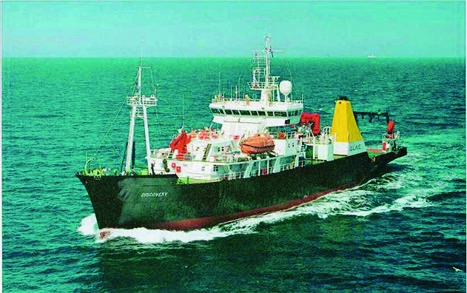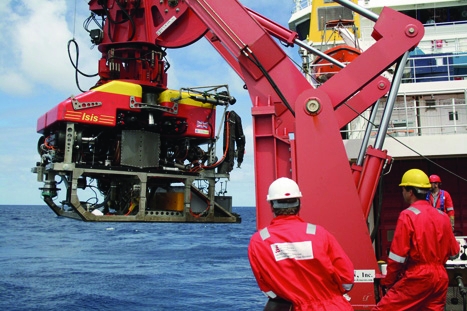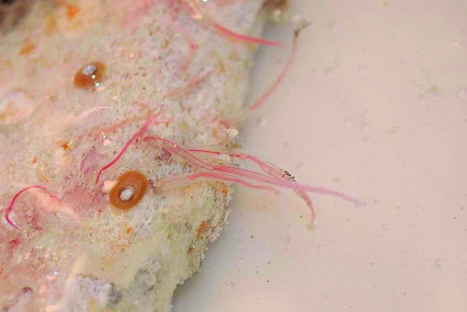
At a time when project cuts and budget constraints are casting doubt over Britain’s scientific future, one programme that’s survived David Cameron’s axe is providing renewed hope that the UK can remain a leader in solving some of the world’s toughest problems.
The £75m replacement of the research ship Discovery has, after two years of delays, secured funding and is now set to provide British scientists with unrivalled access to the rich panorama of the deep ocean. The Natural Environment Research Council (NERC) believes the vessel will usher in a new era of ocean exploration characterised by deeper waters and extreme climates; for this, it says, the ship will use cutting-edge technology.
Today, only around one per cent of the sea floor has been fully explored. That relatively small area, however, has already provided a wealth of information in areas such as natural hazards, biodiversity, and energy sources, and, crucially, it is now helping to unravel the secrets behind climate change.
Britain is currently at the forefront of this research, with expertise in marine geology, geophysics, chemistry and biology. ’I think that’s why, in these hard financial times, we’ve secured the funding to go ahead with a replacement for the Discovery,’ said Edward Cooper, who is heading up the project for the NERC, along with colleague Andrew Jeffries. ’It’s probably about time – when the current Discovery comes out of service it’ll be 50 years old.’
The existing Discovery was built in 1962 by engineering firm Hall and Russell in Aberdeen. It operated for what was then the National Institute of Oceanography and was used for scientific cruises, increasingly becoming available for oceanographic research by British universities in the 1970s. In 1992, a major rebuild was completed to extend the ship’s life for another 15 years. It is now 46 years’ old and parts of its hull structure, main propulsion motor, line shafting and propeller are carrying the risk of major failure.

On top of this, scientists are gradually finding out that Discovery’s capabilities are no longer suitable for current and future scientific needs. The relatively recent introduction of remotely operated underwater vehicles (ROVs) in deep water means that ships today must have the ability to remain in one position, and to do this they need dynamic positioning (DP), a computerised system that uses a combination of sensors and positioning measurements to keep the ship static despite adverse weather conditions.
By the time you get to the Discovery replacement there is no way the whole scientific community are going to have a ship without dynamic positioning
Edward Cooper, Natural Environment Research Council
’Dynamic positioning is key to the whole thing,’ said Cooper. ’On the Discovery when it was refitted, the question was asked about installing DP and it wasn’t very popular. In 2003, when we were building our other research ship, James Cook, DP was seen as useful for some deepwater research. And then you find that by the time you get to the Discovery replacement there is no way the whole scientific community are going to have a ship without DP.’
With DP capabilities on board the replacement Discovery, scientists will be able to use Isis, the UK’s first deep-diving ROV. Isis, which was acquired four years ago, will allow British researchers to retrieve samples of micro-organisms at depths of more than 6,000m. Kim Marshall-Brown, a spokesperson for the NERC, believes ROV technology is what will distinguish this era of oceanographic research. ’ROVs are really bringing ocean technology a whole new chapter forwards,’ she said. ’With this vehicle, our science will be far more detailed and accurate than ever before.’

As well as improved biological research capabilities, the replacement Discovery will host a range of the latest chemical and geophysical research equipment. The requirements for these will change with each mission and the ship is therefore designed to be modular, with scientists able to use a combination of their own equipment and those already installed. ’Historically, one discipline of science used to go to sea,’ explained Jeffries. ’Now you get a multidisciplinary approach and they all complement each other.’
This is where the UK’s strengths in oceanography really lie. ’There are underlying similarities between research ships, but each nation will have its own take on how things should be,’ said Cooper. ’In the UK, we believe all these disciplines are interrelated and it’s important to have a presence in all of them.’ The multidisciplinary set-up of the replacement Discovery, according to Cooper, will place the UK in a strong position to barter ship time and facilities with European and US counterparts, opening up a wealth of international resources. But, he added, there still remains a lot to be done.
At the moment, the NERC is in the process of reviewing detailed design drawings for the new Discovery, which is due to be deployed in 2014. In a move unlikely to be popular with the UK shipbuilding industry, a contract was awarded to Spanish shipyard CNP Freire, and a design contract to Norwegian group Skipsteknisk AS. Meeting the strict requirements of a 21st century flagship research vessel is no easy task and the design has already undergone several iterations. One of the difficulties is that scientists are increasingly interested in unusual events and more often than not these occur in extreme conditions.
’About 10 years ago, there was a cruise on Discovery up towards Iceland and Greenland,’ said Cooper. ’The problem was that the scientists came back and tried to compare their results with other people and they couldn’t find anyone who was daft enough to go there. But it was really interesting science, key to understanding the way the climate is changing, and now they tend to go back there year on year… any future research ship has to be capable of operating in these extreme conditions.’
The replacement Discovery is designed to operate in air temperatures of 45°C to -20°C and water temperatures of 35°C to -2°C. In these environments, the instrumentation on board must be protected against any possible interference. One problem is the effect of water turbulence on the variety of acoustically based sensors and navigation aids located beneath the ship. ’If air gets caught underneath the ship as it’s pitching up and down on the water it blocks the reception of the equipment,’ said Jeffries. ’So the ship has to be able to cut cleanly through the water without generating bubbles and that’s unfortunately one of the issues with James Cook.’

Jeffries explained that the new Discovery will be sharper at the front and deeper in the water than its predecessor. They have also scrapped designs for a bulbous bow to help reduce the effects of aeration. But water turbulence isn’t the only issue. ’Another problem affecting the performance is noise.’ said Jeffries. ’Considering there are four massive diesel engines inside the ship, reducing noise is quite a challenge. The actual thrusters we are buying are the best low noise and the propellers are bigger and rotate more slowly. We also have a special gearbox with fine precision-engineered gears, and the motors and generators behind them are placed on resilient mounts. It’s a combination of high-tech stuff with finer elements.’
The ship will be home to 28 scientists and 24 crew, taking them to areas previously thought inaccessible. ’You can appreciate the challenges BP has got in the Gulf of Mexico with the oil rig,’ said Cooper. ’That’s only one mile down (1,130m). But with Discovery, we’ll be able to meet some of those challenges at depths of more than 6,000m. It’s an exciting prospect and one that we’re glad the UK is leading in. Like the current Discovery, I’d be surprised if the one we are going to complete is not around in 40 or 50 years’ time.’

The replacement Discovery, 99.7m long and capable of lifting loads of 20 tonnes, will be equipped with dynamic positioning capability
Blueprint ship stats
How the design of the replacement Discovery is shaping up
Replacement Discovery stats:
Length 99.7m; Breadth 18m; 6.5m
Maximum transit speed: 12 knots
Top speed: 15 knots
Overside/overstern lifting: 20 tonnes
Accommodation: 24 officers and crew; 28 scientists
Home port: Southampton, Hampshire
Deep thinking
James Cook has helped revolutionise understanding of deep-sea life in the Atlantic
Last month, scientists returned with samples of rare animals and more than 10 possible new species following a six-week voyage in the Atlantic Ocean aboard the research vessel James Cook.
The cruise was part of MAR-ECO – a research programme involving scientists from 16 nations with the UK contribution led by Aberdeen University. The project’s aim was to increase understanding of the occurrence, distribution and ecology of animals along the Mid-Atlantic Ridge between Iceland and the Azores.
With dynamic positioning capabilities on board the James Cook, researchers were able to use the UK’s deepest-diving ROV, Isis, which went to depths of between 700m to 36,000m surveyed flat plains, cliff faces and slopes of the giant mountain range that divides the Atlantic Ocean. Prof Monty Priede, director of Aberdeen University’s Oceanlab, said: ’We were surprised at how different the animals were on either side of the ridge, which is just tens of miles apart. The terrain looked the same, mirror images of each other, but that is where the similarity ended. It seemed like we were in a scene from Alice Through the Looking Glass.’
Priede added that the expedition had revolutionised thinking about deep-sea life in the Atlantic Ocean. ’It shows that we cannot just study what lives around the edges of the ocean and ignore the vast array of animals living on the slopes and valleys in the middle of the ocean.’ The expedition, which surveyed more than 50,000m2 of sea floor, is thought to be one of the most detailed video surveys of the deep sea ever attempted. The introduction of the new Discovery, which will complement the work of James Cook, is expected to allow scientists to make more use of Isis and future deep-diving ROVs in the coming decade.




Nanogenerator consumes CO2 to generate electricity
Whoopee, they've solved how to keep a light on but not a lot else.